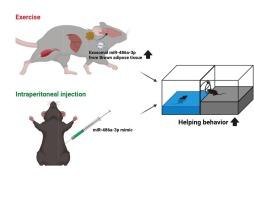低强度运动诱导的miR-486a-3p分泌对增强小鼠共情行为的潜在贡献:可能涉及棕色脂肪组织
IF 2.6
4区 医学
Q3 NEUROSCIENCES
引用次数: 0
摘要
同理心在维持哺乳动物之间的人际关系中起着至关重要的作用。值得注意的是,从事轻强度运动已被确定为共情行为的促进者,这一现象与岛叶皮层中miR-486a-3p的上调有关。然而,miR-486a-3p的作用及其在岛叶皮层中随轻强度运动水平变化的机制尚不清楚。我们初步评估了低强度运动(7.0米/分钟,30分钟/天,每周5天,持续4周)对帮助行为、岛叶皮质mRNA和外周组织外泌体miR-486a-3p分泌的影响。随后,我们探讨了在两周内每天腹腔注射miR-486a-3p模拟物对帮助行为的影响。轻强度运动的干预,增强了帮助行为,导致岛叶皮层miR-486a-3p和血浆外泌体miR-486a-3p水平升高。有趣的是,运动干预导致来自棕色脂肪组织的外泌体miR-486a-3p显著增加,而在来自腓肠肌或肝脏的外泌体中没有观察到这种增加。此外,mmu-miR-486a-3p模拟物在小鼠中表现出类似的帮助行为增强。值得注意的是,运动干预和miR-486a-3p模拟处理均导致岛叶皮层Pten mRNA下调和Bdnf mRNA上调。我们的研究结果表明,源自棕色脂肪组织的外周源性miR-486a-3p的增加可能支持与轻强度运动相关的共情增强。此外,miR-486a-3p可能与轻强度运动对共情有相似的影响,为解决共情相关行为提供了一种潜在的方法。本文章由计算机程序翻译,如有差异,请以英文原文为准。

The potential contribution of light-intensity exercise-induced miR-486a-3p secretion on enhancing empathic behavior in mice: Possible involvement of brown adipose tissue
Empathy plays a crucial role in the maintenance of interpersonal relationships among mammals. Remarkably, engaging in light-intensity exercise has been identified as a facilitator of empathic behavior, a phenomenon associated with the upregulation of miR-486a-3p in the insular cortex. However, it remains to cover the contribution of miR-486a-3p and the mechanisms of changing levels of that in the insular cortex with light-intensity exercise. We initially assessed the impact of light-intensity exercise (7.0 m/min, 30 min/day, five days/week for four weeks) on helping behavior, mRNA in their insular cortex, and the secretion of exosomal miR-486a-3p from their peripheral tissues. Subsequently, we explored the effects of a daily intraperitoneal injection of miR-486a-3p mimic over a two-week period on helping behavior. The intervention of light-intensity exercise, which enhanced helping behavior, resulted in elevated levels of miR-486a-3p in the insular cortex and exosomal miR-486a-3p in the plasma. Interestingly, the exercise intervention led to a marked increase in exosomal miR-486a-3p derived from brown adipose tissue, whereas no such increase was observed in exosomes originating from the gastrocnemius muscle or the liver. Moreover, the administration of mmu-miR-486a-3p mimic exhibited a similar enhancement of helping behavior in mice. Notably, both the exercise intervention and miR-486a-3p mimic treatment led to the downregulation of Pten mRNA and upregulation of Bdnf mRNA in the insular cortex. Our findings suggest that the increase in peripheral-derived miR-486a-3p, originating from the brown adipose tissue, may support empathy enhancement associated with light-intensity exercise. Additionally, miR-486a-3p may have similar effects to light-intensity exercise in relation to empathy, providing a potential approach for addressing empathy-related behaviors.
求助全文
通过发布文献求助,成功后即可免费获取论文全文。
去求助
来源期刊

Brain Research
医学-神经科学
CiteScore
5.90
自引率
3.40%
发文量
268
审稿时长
47 days
期刊介绍:
An international multidisciplinary journal devoted to fundamental research in the brain sciences.
Brain Research publishes papers reporting interdisciplinary investigations of nervous system structure and function that are of general interest to the international community of neuroscientists. As is evident from the journals name, its scope is broad, ranging from cellular and molecular studies through systems neuroscience, cognition and disease. Invited reviews are also published; suggestions for and inquiries about potential reviews are welcomed.
With the appearance of the final issue of the 2011 subscription, Vol. 67/1-2 (24 June 2011), Brain Research Reviews has ceased publication as a distinct journal separate from Brain Research. Review articles accepted for Brain Research are now published in that journal.
 求助内容:
求助内容: 应助结果提醒方式:
应助结果提醒方式:


